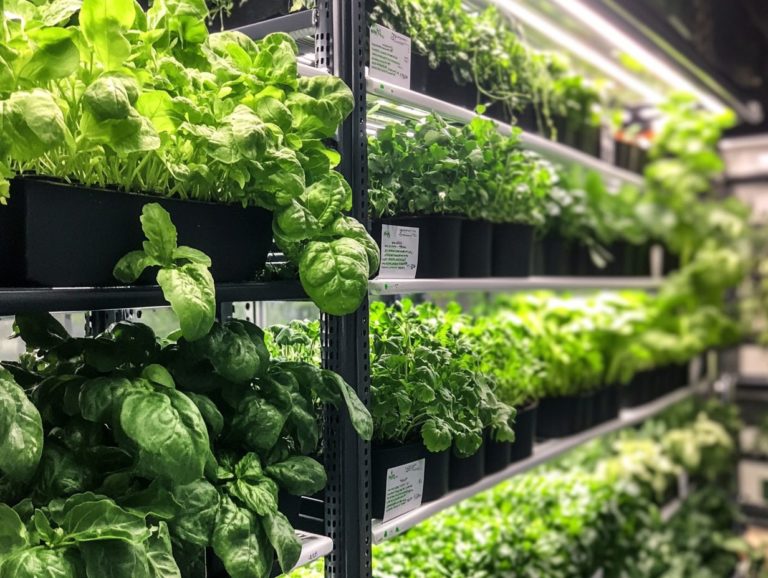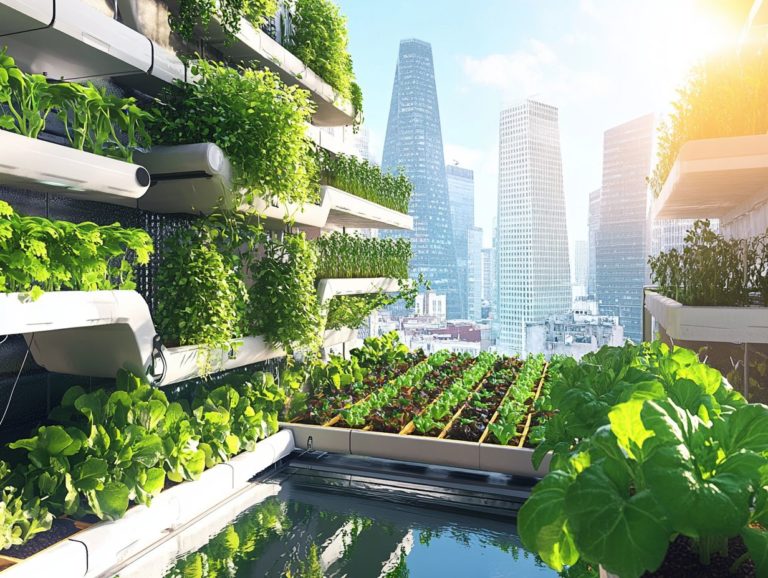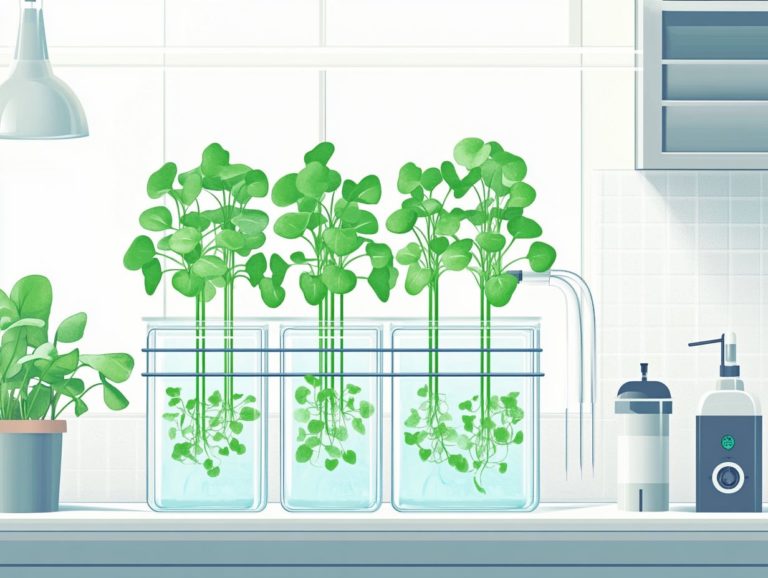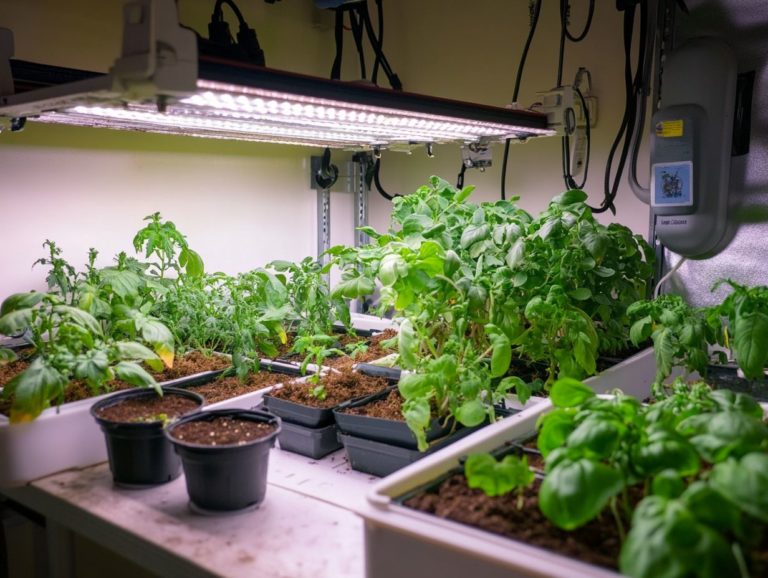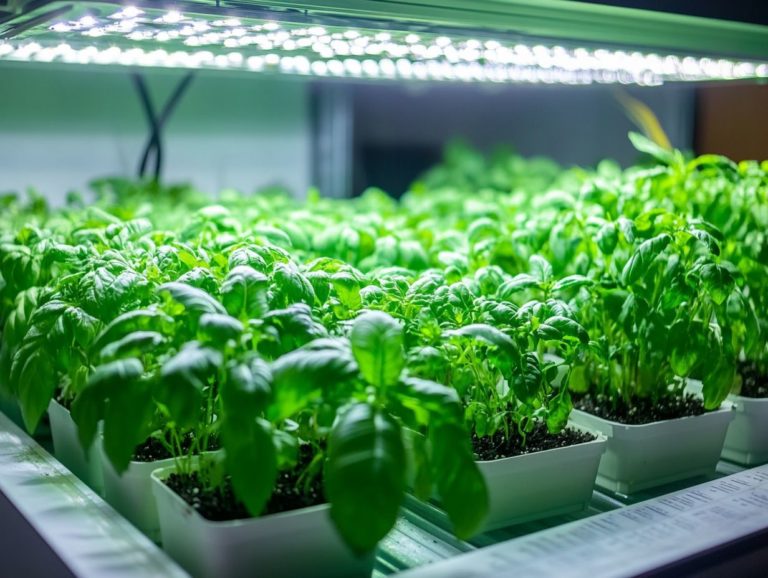Choosing the Right Hydroponic System for Your Space
Hydroponics is revolutionizing the way you grow plants. It provides a soil-free alternative that optimizes both efficiency and yield, especially for urban gardeners looking to maximize their growing capacity.
Before you dive into the world of hydroponic systems, there are key factors to weigh. Consider your space limitations, the crop types you wish to cultivate, your budget, and your maintenance preferences. Each of these elements plays a crucial role in your decision-making process.
This article will serve as your guide through the various types of hydroponic systems. It will help you pinpoint the perfect fit for your setup, from Deep Water Culture to Nutrient Film Technique. Whether you re a beginner or aiming to deepen your existing knowledge, you ll discover the best options to create your green oasis.
Contents
- Key Takeaways:
- Factors to Consider Before Choosing a Hydroponic System
- Types of Hydroponic Systems
- Choosing the Right Hydroponic System for Your Space
- Frequently Asked Questions
- What factors should I consider when choosing the right hydroponic system for my space?
- What are the different types of hydroponic systems?
- Which hydroponic system is best for small spaces?
- What kinds of plants can I grow in a hydroponic system?
- How much maintenance do hydroponic systems require?
- Can I build my own hydroponic system?
Key Takeaways:
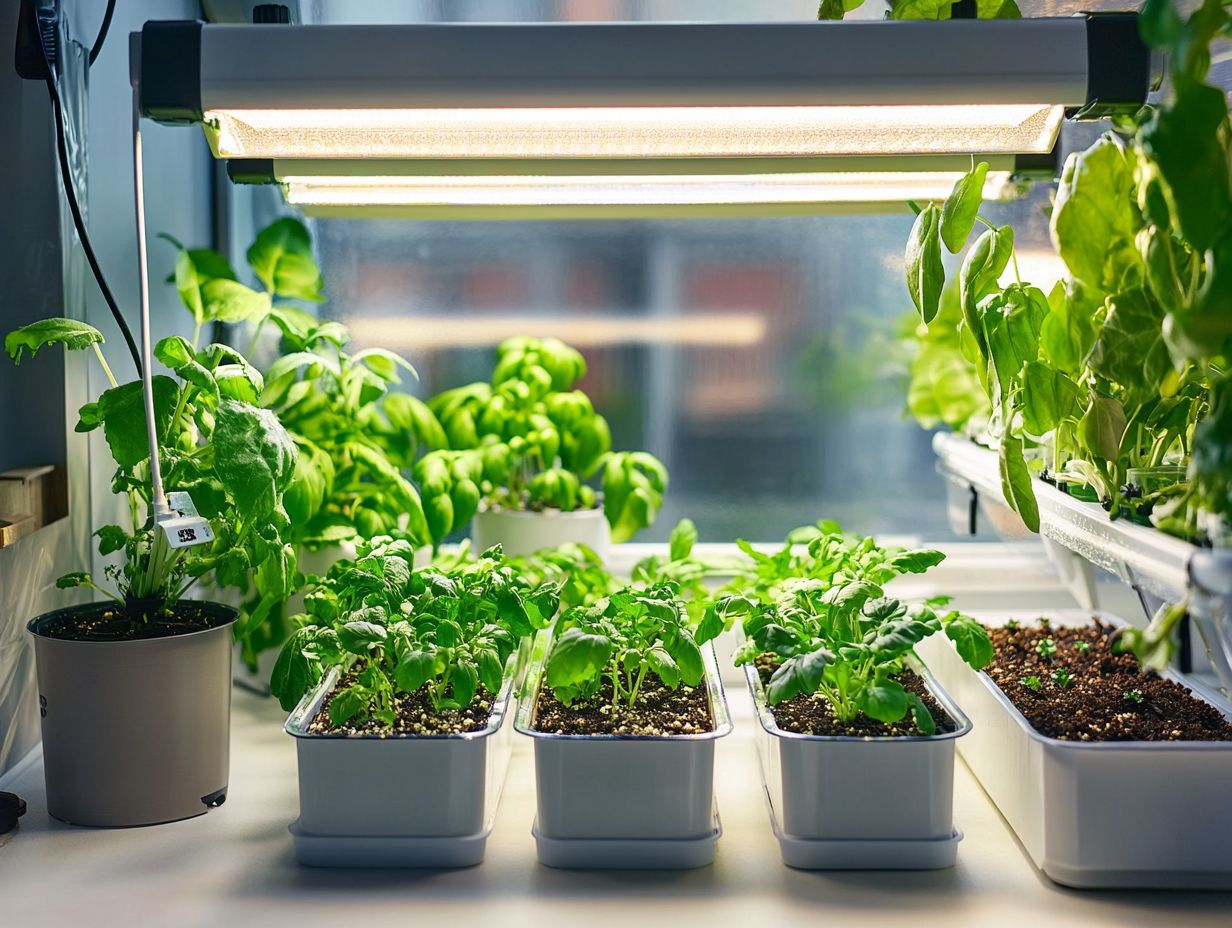
- Consider available space and plant type when choosing a hydroponic system.
- Keep budget and maintenance needs in mind when selecting a hydroponic system.
- Match the system with your space and plant type for successful hydroponic growth.
What is Hydroponics?
Hydroponics is your ticket to an innovative, soil-less gardening experience. It uses nutrient-rich water to deliver essential minerals directly to plant roots. This method is great for urban gardeners. You can maximize your growing potential even in limited space.
With hydroponics, you can enjoy higher yields and adapt the system to various crop types. This significantly enhances your gardening journey in areas where traditional methods may fall short.
Hydroponics removes the guesswork by providing a controlled environment. Techniques like Deep Water Culture and Nutrient Film Technique showcase this flexibility, allowing you to manage both water and nutrients efficiently.
As an urban gardener, you’ll appreciate how these systems not only save space but also foster faster growth rates and minimize pest problems. Controlling environmental variables such as pH levels, light, and temperature ensures that your crops thrive. For those interested in large scale gardening, exploring the best hydroponic systems is a groundbreaking choice for city dwellers eager to cultivate their own fresh produce.
Factors to Consider Before Choosing a Hydroponic System
Choosing the right hydroponic system is exciting! It s your chance to create a thriving garden. Thoughtful consideration of various factors will guarantee optimal plant growth and sustainability.
Assess your available space, the types of crops you want to cultivate, your budget, and the maintenance requirements tied to different systems. By grasping these variables, you can choose one of the top hydroponic growing systems for beginners that aligns perfectly with your preferences and gardening objectives.
Space Considerations
The available space for your hydroponic setup is pivotal in determining which system suits your needs best, particularly in urban gardening scenarios where space can be a premium.
Embracing vertical gardening techniques and compact systems can dramatically elevate your gardening potential. Ensure every square inch is utilized efficiently, whether you re tending to your plants indoors or outdoors.
This strategy enables those with limited space to cultivate an impressive variety of plants without compromising on quality or yield. For instance, by stacking planters or utilizing wall-mounted systems, you can transform even a modest balcony or kitchen corner into a vibrant green oasis.
These innovative methods not only optimize the available area but also enhance air circulation and light absorption crucial elements for successful indoor gardening. Compact hydroponic systems, like nutrient film techniques (NFT) or aeroponics, further ensure that every inch of your urban space is put to excellent use.
Don’t miss out on the chance to grow your own fresh produce!
Types of Plants to be Grown
Selecting the right plants for your hydroponic system is crucial to your success. Some crops thrive in soil-less environments, while others may struggle.
If you’re an urban gardener, consider popular options like tomatoes, peppers, lettuce, and various herbs. These choices can flourish beautifully when given the right nutrient solution and controlled environment.
Take leafy greens, for example. Crops like spinach and kale grow rapidly in nutrient-rich solutions, making them perfect candidates for systems like Nutrient Film Technique (NFT), which allows a thin film of nutrient solution to cascade over their roots.
If you re eyeing fruiting plants such as cucumbers and strawberries, Deep Water Culture (DWC) is ideal. This method lets their roots bask in oxygenated water, promoting robust growth.
Don t underestimate herbs like basil and mint. They thrive particularly well in aeroponic systems, which mist their roots to ensure they receive the optimal balance of moisture and nutrients. Each system offers unique benefits, tailored for different plants and gardening styles, such as enhanced water efficiency and quicker growth rates.
Budget and Maintenance
Establishing a budget and understanding maintenance requirements are vital steps as you embark on your hydroponic gardening journey. These elements directly influence the efficiency and sustainability of your system.
Your budget should cover not just the initial setup costs but also ongoing energy consumption and essential tools for nutrient monitoring and pest control.
Choosing the right hydroponic system, be it Deep Water Culture or Nutrient Film Technique, can vary significantly in price and complexity. For those with limited space, exploring the top hydroponic systems for small spaces can be beneficial. By carefully assessing your initial investment against anticipated yields, you can craft a strategic budget plan that balances affordability with productivity.
Make sure you grab those essential maintenance tools they’re key to your success! Tools like pH testers, nutrient solutions, and specialized lighting can add up to ongoing expenses. However, the rewards often outweigh these costs, with quicker growth cycles and higher crop yields compared to traditional gardening. This positions hydroponics as a financially savvy choice for many enthusiasts.
Types of Hydroponic Systems
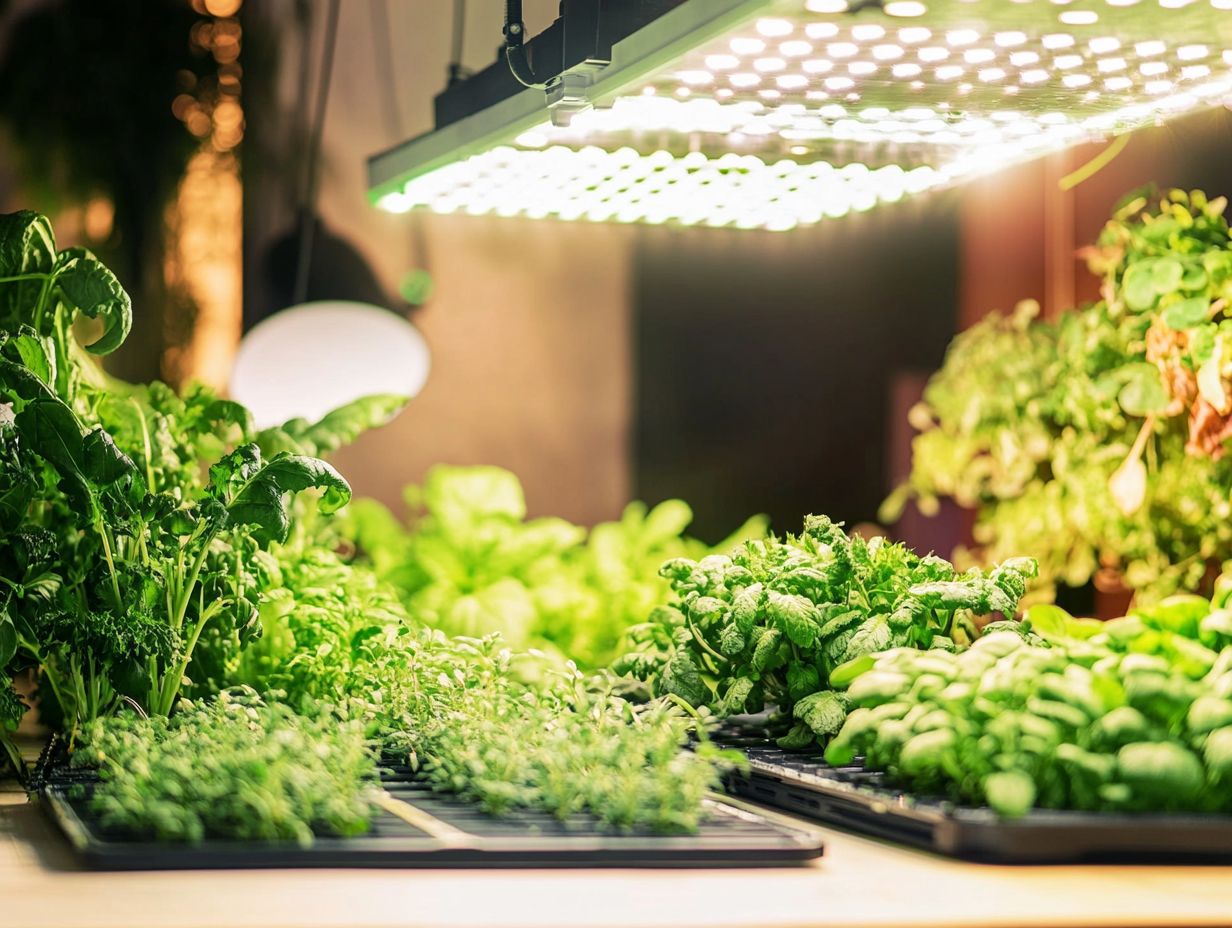
Understanding the different types of hydroponic systems is crucial for you as an urban gardener aiming to adopt an effective soil-less growing method. Each system presents distinct advantages and challenges.
Popular options like Deep Water Culture, Nutrient Film Technique, Ebb and Flow, and Aeroponics cater to various growing techniques and crop types, providing you with flexibility in both setup and management. For those specifically interested in herbs, exploring the best hydroponic systems for herbs can enhance your gardening experience.
Deep Water Culture (DWC)
Deep Water Culture (DWC) is a standout hydroponic system that excels in nutrient delivery. Imagine plant roots suspended in a nutrient-rich solution, enjoying optimal oxygenation and nutrient absorption. Its simplicity and effectiveness make it an ideal choice for urban gardeners like you, aiming for high yields and reduced maintenance requirements with minimal fuss.
Setting up a DWC system requires just a few essential components:
- a reservoir
- an air pump
- net pots to hold your plants securely
The straightforward assembly means even novice gardeners can jump in without feeling overwhelmed. This design is especially suited for fast-growing crops like lettuce and herbs, which thrive in the oxygen-rich environment DWC creates. For more information, check out our guide on hydroponic systems.
Many enthusiasts note a significantly lower incidence of pests and diseases compared to traditional soil gardening, enhancing the allure of this hydroponic method. Those who embrace DWC often rave about their experiences, praising the ease of monitoring nutrient levels and the sheer satisfaction of watching their plants grow rapidly.
Drip System
The drip system is a way to grow plants without soil that delivers a mix of water and nutrients directly to your plant roots through an intricate network of tubes and emitters. This approach provides unparalleled precision in nutrient delivery and moisture management.
Its versatility allows you to use various growing mediums, making it suitable for various crops in both indoor and outdoor environments. By ensuring that water and essential nutrients reach the roots efficiently, hydroponic systems for home gardeners significantly minimize waste and foster healthier plant growth.
Crops like tomatoes, cucumbers, and peppers thrive in conditions optimized by drip irrigation, benefiting immensely from the consistent moisture levels it maintains. This method also lowers the risk of soil-borne diseases since it bypasses traditional soil entirely, making it an ideal choice for enhancing crop yields while conserving water.
The focused delivery of nutrients promotes stronger root development, resulting in resilient plants that can better withstand environmental stressors.
Nutrient Film Technique (NFT)
Nutrient Film Technique (NFT) is an advanced hydroponic system that uses a thin film of nutrient-rich water cascading over plant roots, fostering remarkable oxygenation and nutrient absorption. This method is perfect for growing delicious leafy greens and herbs, making it a go-to choice for urban gardeners aiming for high-quality produce.
The seamless design of NFT systems ensures a continuous flow of water, maintaining optimal moisture levels while drastically reducing the risk of waterlogging. With a carefully engineered water circulation system, your plants can effortlessly absorb just the right amount of nutrients.
This precision offers distinct advantages over traditional hydroponic methods, including reduced water usage and accelerated growth rates. NFT is particularly well-suited for fast-growing crops like lettuce and basil, enabling you to achieve higher yields in less time while maximizing productivity within limited spaces.
Ebb and Flow System
The Ebb and Flow system, also known as flood and drain, presents a dynamic hydroponic approach that periodically floods your growing area with nutrient solution before draining it away. This technique gives your plant roots all the nutrients they crave while preventing waterlogging.
It’s a versatile system, ready to accommodate various growing mediums and perfectly suited for a wide range of crops like tomatoes and peppers. To optimize your setup, consider how to choose grow lights for hydroponics. By managing water circulation effectively, this system boosts nutrient uptake, leading to healthier plants and faster yields.
You ll appreciate the flexibility to use materials like clay pellets, rock wool, or peat, all of which enhance root aeration and water retention. However, you’ll need to maintain consistent timing and watch for potential pump failures.
Despite these hurdles, the operational efficacy and adaptability of the Ebb and Flow method make it a favored choice among both hobbyists and commercial cultivators, driving innovation in the world of modern agriculture.
Ready to dive into the world of hydroponics? Explore these systems and discover how to optimize your hydroponic layout and transform your gardening experience!
Aeroponics
Aeroponics is an innovative hydroponic system that allows you to suspend plant roots in the air while misting them with a nutrient solution. With this system, plants thrive on pure oxygen and nutrient mist! This advanced approach is particularly efficient in terms of space utilization, delivering high yields of quality crops a fantastic choice for urban gardeners who are committed to sustainability.
By eliminating soil, aeroponics significantly reduces the risk of pests and diseases, resulting in healthier plants. The precise delivery of nutrient solutions guarantees that each plant gets exactly what it needs for growth, enhancing both taste and nutritional value.
You ll find that many leafy greens, herbs, and even certain fruiting plants thrive in this environment, highlighting the system’s versatility. The system uses less water than traditional methods, making it a sustainable option for growers eager to make a positive environmental impact.
Choosing the Right Hydroponic System for Your Space
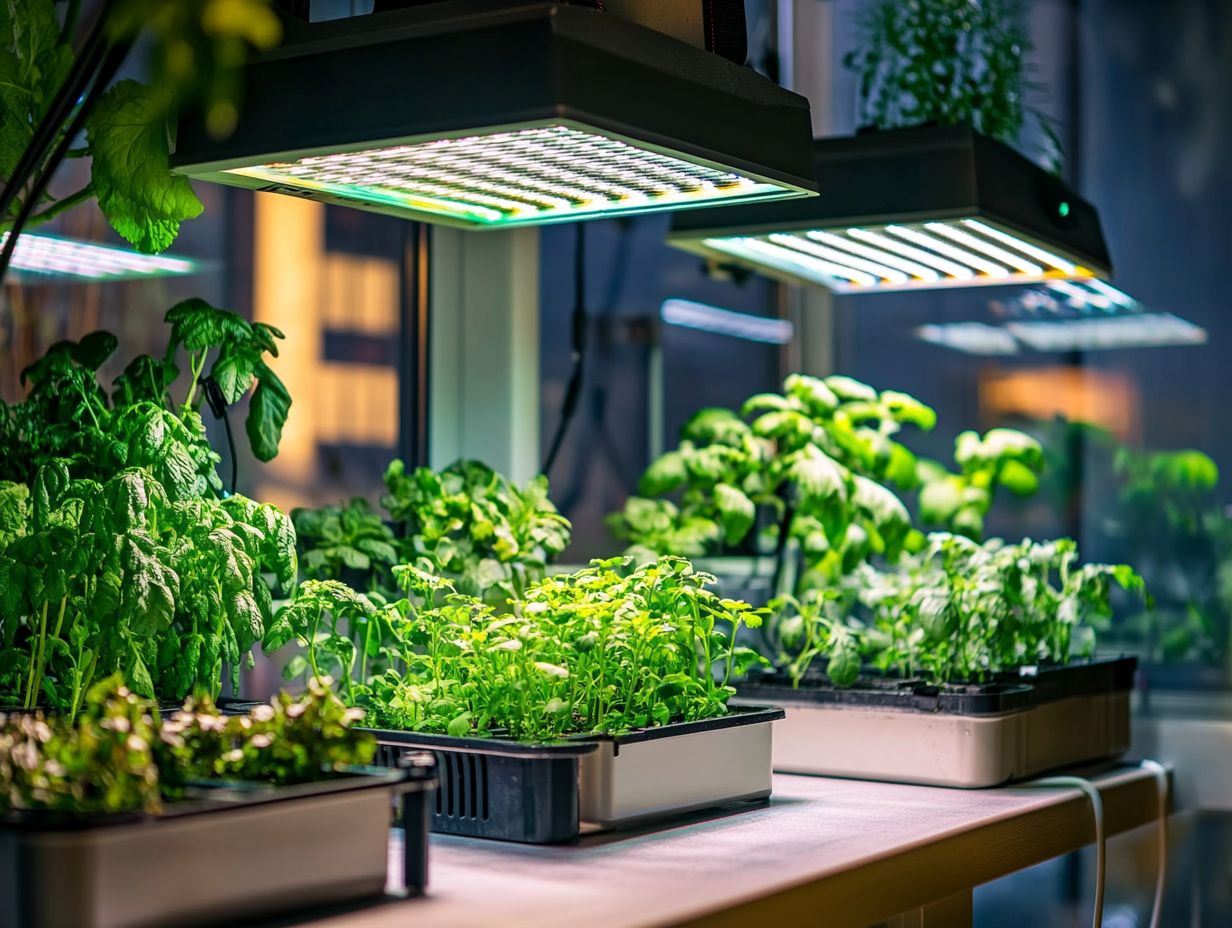
Selecting the ideal hydroponic system that suits your available space, crop type, budget, and personal preferences is crucial for achieving success in indoor gardening. Each system presents its own unique advantages and challenges.
By understanding these nuances, you enable yourself to make informed decisions that align seamlessly with your gardening aspirations. Factors such as maintenance requirements, which refer to the care needed to keep your system running smoothly, and energy consumption should guide your system choice.
Matching System with Available Space and Plant Type
Matching your chosen hydroponic system with your available space and specific plant types is essential for creating an optimal growing environment. For instance, vertical gardening systems, which allow plants to grow upwards and save space, can be an ideal solution for maximizing limited space while accommodating a variety of crops, from herbs to larger vegetables.
In urban settings where space is at a premium, utilizing vertical hydroponics can transform a small balcony or indoor area into a vibrant oasis. To effectively implement these systems, understanding the basics of hydroponic systems is crucial. These systems not only enhance the aesthetic appeal but also boost yield, allowing you to cultivate a diverse range of plants, including leafy greens, strawberries, and even flowering herbs.
Understanding how to pair the right system with your desired crops is crucial for achieving thriving yields. Factors like light exposure and water access should guide your system choice, ensuring that each plant type flourishes in its designated spot, ultimately leading to bountiful harvests. For insights on innovative setups, explore the future of hydroponic growing systems.
Considering Budget and Maintenance Needs
When selecting a hydroponic system, consider your budget and maintenance needs. These factors greatly affect its long-term efficiency and sustainability.
Evaluate aspects like initial costs, ongoing energy consumption, and tools for nutrient monitoring. This will help you make an informed choice.
As a potential grower, assess the varied costs associated with different hydroponic systems. Each type, from deep water culture to nutrient film techniques, has its own requirements.
Basic tools include grow lights and pumps. You ll also need meters to check pH (acidity) and electrical conductivity (nutrient concentration).
Understanding these financial implications helps you anticipate setup costs and ongoing expenses like electricity and water.
By budgeting wisely, you can find the perfect hydroponic system that meets both your economic and operational needs.
Frequently Asked Questions
What factors should I consider when choosing the right hydroponic system for my space?
When choosing a hydroponic system, you should consider the space available, budget, desired crops, and maintenance requirements. Understanding the differences in growing techniques can also be beneficial.
What are the different types of hydroponic systems?
Some common types include deep water culture, ebb and flow, drip, and aeroponics. Each system has its own unique benefits and challenges, making them suitable for various crop types and growing mediums.
Which hydroponic system is best for small spaces?
If you have limited space, consider a vertical hydroponic system or a compact system like the wick system. These systems take up less horizontal space while still providing optimal growing conditions. Implementing smart technology can further enhance efficiency.
What kinds of plants can I grow in a hydroponic system?
You can grow many plants in a hydroponic system. This includes vegetables, herbs, fruits, and even flowers.
Some plants need specific plant food and growing conditions. Researching beforehand is important for success.
Many growers have success with lettuce and tomatoes.
How much maintenance do hydroponic systems require?
The maintenance required depends on the type of system you choose. Some systems may need daily monitoring and adjustments.
Others may only require regular changes of the nutrient solution and occasional cleaning. Effective pest control can minimize additional maintenance.
Can I build my own hydroponic system?
Absolutely! You can build your own hydroponic system. Many exciting DIY tutorials are available online to guide you.
Make sure you gather the right materials and knowledge. This ensures your plants thrive in optimal conditions!

